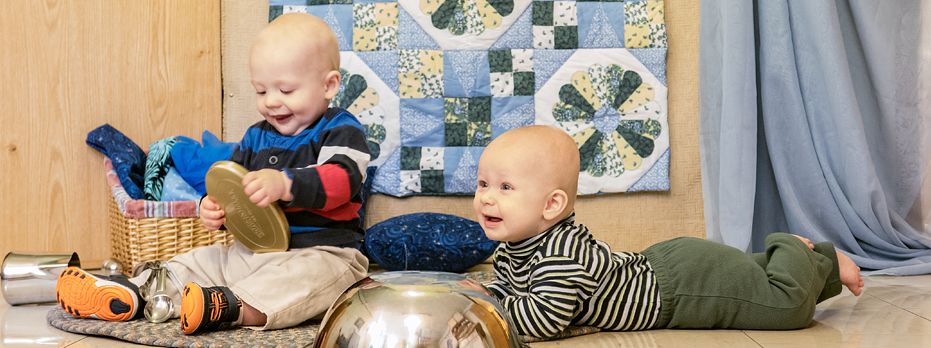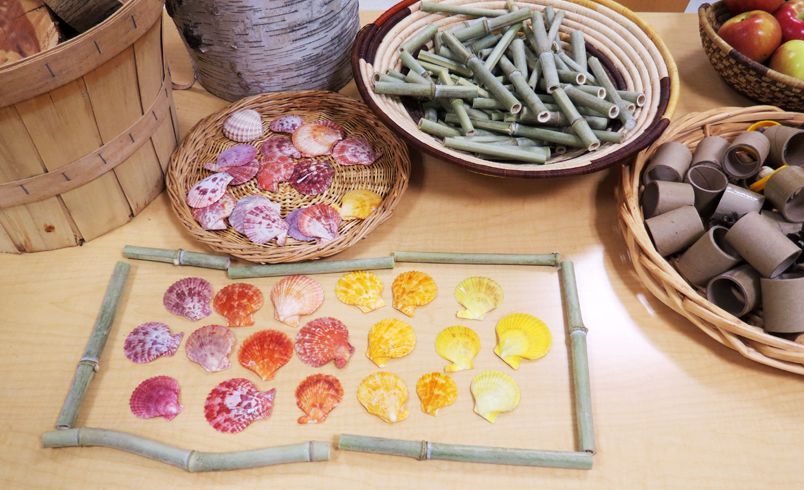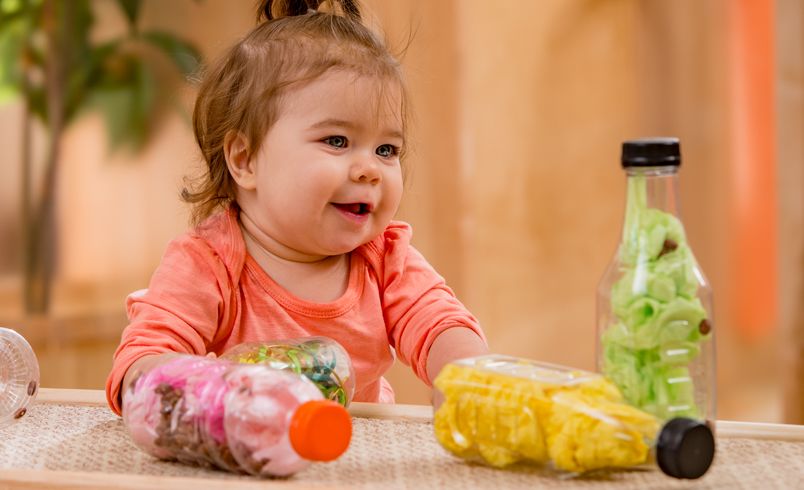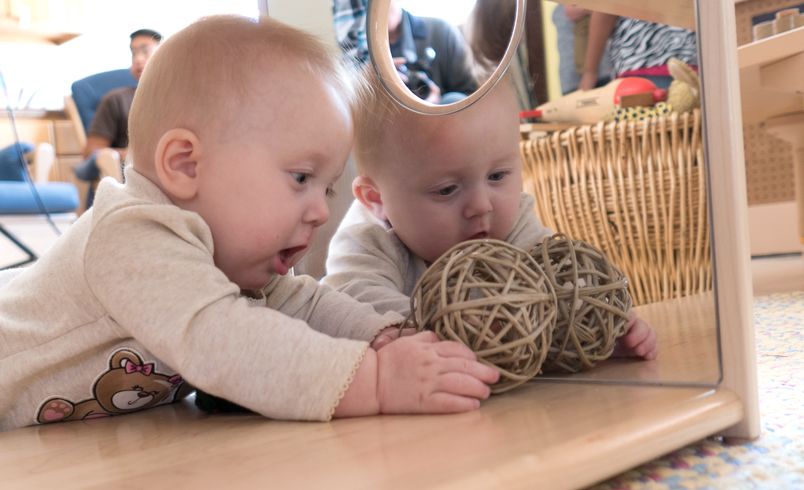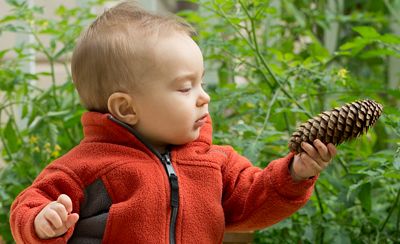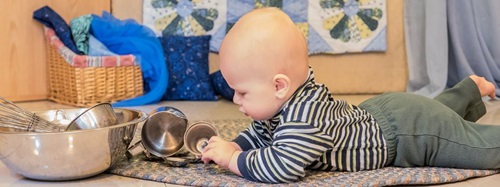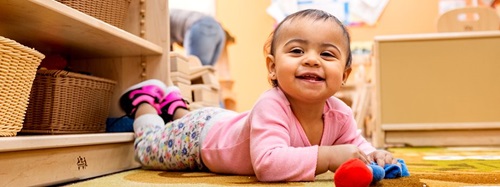Loose Parts 2: Inspiring Play with Infants and Toddlers
| October 2017When loose parts are introduced to infants and toddlers, rich, magnificent explorations transpire. Astonishing learning and unexpected capabilities are revealed as the youngest of children make sense of their world. Accidental occurrences become significant and visible as caregivers thoughtfully observe children’s engagement with materials, reflect on the importance of the interactions, and respectfully respond to children’s intentions.
Infants and toddlers are researchers who are fascinated by the properties of objects and how things work. They explore materials with all their senses and delight in cause-and-effect relationships. Loose parts are captivating objects for infants and toddlers to investigate because of their open-ended nature. Loose parts allow young children to be in control of their inquiries as they gather and learn information about physical objects.
What Are Loose Parts?
The term loose parts was originally coined by British architect Simon Nicholson to describe open-ended materials that can be used and manipulated in different ways (Nicholson 1971). They have unlimited play possibilities rather than single outcomes, which means that there is not a specific way to use items. A plastic musical toy is a closed object that has one intent: sound is made as an infant pushes a button. Toy manufacturers claim that infants will be delighted by its vivid colors, fascinating texture, and engaging sounds. The reality is that the novelty of such a toy wears off very quickly. Once a young child has mastered the single task of making a sound, he is ready to move on to another challenge. Loose parts, however, are adaptable and provide young children with infinite play possibilities.
Why Loose Parts for Infants and Toddlers Are Important
When incorporating loose parts for infants into your environment consider appropriate items that invite action and opportunity for babies to touch, mouth, explore, move, bang, and rearrange. Examples include balls, knotted cloth napkins, hair rollers, and bracelets. For toddlers, select items that they may transform, transport, and construct. When a toddler plays with a plastic apple it is always an apple, but when she plays with a pinecone she may choose for it to represent an apple, a tree, or a ball for rolling—anything that she imagines.
Toddlers love to fill, dump, and carry things, so provide materials to support these interests, such as coasters, large glass stones, rocks, postcards, and scarves. Also add materials with interesting properties that can be used for design or construction, or made into props. Natural, found, and upcycled objects such as seashells, stones, tiles, ribbon, and fabric are some examples.
Infants and toddlers learn heuristically, that is through investigating, discovering, or problem solving by experimental and trial-and-error methods. Therefore, it is important for teachers and caregivers to provide open-ended materials (loose parts) that allow infants and toddlers opportunity to explore their properties and functions.
Loose parts support the dynamic and multidimensional nature of young children’s learning. Children of all ages, abilities, skill levels, and genders can use loose parts successfully. Because there’s no right or wrong way to work with these items, infants and toddlers may use them according to their ability and interest. For example, a young infant may look at, feel, grasp, and mouth a large, polished tile sample; a mobile infant may stack the tiles; and an older toddler may fill a bucket with them and then dump them out.
Loose Parts Support Learning and Development across the Domains
Social-Emotional Learning and Development
Play with loose parts promotes social-emotional development, including self-knowledge, self-regulation, self-esteem, and social skills as infants and toddlers get to know themselves and others.
- Self-knowledge includes a child’s understanding of his own body, abilities, and feelings. An infant first begins to make sense of his world through his sense of touch, sight, taste, hearing, smell, and through movement. As young children explore intriguing loose parts that are made available to them, they use their senses and movement in new ways, developing an awareness of their own capabilities.
- Self-regulation involves infants and toddlers ability to gain control of bodily functions, manage powerful emotions, and maintain focus and attention (Shonkoff and Phillips 2000). The development of self-regulation is seen in all developmental areas as young children gain control emotionally, socially, physically, and cognitively. Children become deeply involved and interested, even in the presence of distractions, when they have interesting loose parts to examine and manipulate. Having sufficient time to investigate play objects allows infants and toddlers the ability to fully experience and dictate how to play. The open-ended nature of loose parts allows for multiple play possibilities, such as carrying, stacking, banging, or collecting, thus offering a child the opportunity to regulate her play as she desires, which is not the case with a single-purpose manufactured toy. Self-chosen play with loose parts fosters children’s capacity to control their environment.
- Self-esteem is an individual’s perception of their own worth. It develops as children master new abilities, experience success, and realize their effectiveness. Self-esteem and feelings of efficacy develop as young children take initiative and conquer challenges. Pride in their accomplishments and development of independence may be seen in exploratory play with loose parts when infants and toddlers engage with objects and interesting things happen as a result of their actions.
- Social development is a young child’s ability to form and maintain healthy and rewarding relationships with adults and other children. An environment organized with appealing loose parts plays a major role in supporting social play in young children. Toddlers can be intent on having the same play object that someone else has, especially popular items. Loose parts are duplicates of the same items so conflict and waiting among children is automatically minimized. For example, a wide variety of metal spoons could be set up as a provocation (intentionally placing intriguing, challenging, or surprising materials in the environment as a way to provoke children’s thinking). Because there are multiple spoons, each child can take several at a time for their investigations of dropping, banging, lining up, batting, transporting, pushing, and stirring.
Perceptual-Motor Learning and Development
As infants and toddlers engage with loose parts they are continuously investigating and experimenting to make sense of how their world works. They learn about texture as they touch scratchy loofas, soft blankets, and smooth plastic bowls. They investigate gravity by rolling a ball down an incline or dropping it from up high. Play with loose parts promotes gross-motor skills, fine-motor skills, and hand-eye coordination.
Gross-motor skills are evident when children climb on pillows or up ramps, pick up heavy tree cookies with both arms, and chase balls. Balance develops as young children walk across logs, stepping stones, tree trunk borders, or a wood plank bridged between tires. Transporting items and filling/dumping are large-motor skills repeated frequently by toddlers. It’s important to have containers in the environment such as bags, buckets, and crates along with smaller loose parts that children can fill, transport, dump, and refill. Tree blocks, pinecones, small floor samples (tile, carpet, wood), coasters, and napkin rings make good small loose parts, and sand, water, and clay are natural loose parts.
Fine-motor skills include control and accuracy of actions made with the small muscles of the hands. Small-motor skills increase when infants and toddlers grasp a knotted rope, carefully use their index finger and thumb in a pincer grasp to pick up a cedar ring, or clip round peg wood clothespins onto a metal bucket. Pouring is supported when young children use cups and containers for pouring water or birdseed. Play with loose parts supports the development of other fine-motor skills such as moving a small cup from hand to hand, making mud pies and cakes, dropping and picking up bracelets, and banging a spoon on a metal pot.
Cognitive Learning and Development
Intellectual, or cognitive, learning includes the abilities of predicting, reasoning, questioning, and analyzing. The process of intellectual learning takes place through natural interaction with real things in the child’s environment (Katz 2015). Infants and toddlers have a natural desire to explore the properties of objects, so exposing them to open-ended play with loose parts allows for experimentation and fosters higher-level thinking. Loose parts are the tools of scientists, engineers, artists, and architects. An early childhood environment filled with loose parts is a laboratory that supports a young child’s drive to invent and discover, a catalyst for rich problem solving.
Language and Communication Learning and Development
Language has many uses as young children engage with loose parts. Sound effects may be used to describe actions as evidenced by Samuel, who makes a “vrooming” sound while pretending that a piece of bark is a car and later makes a “whistling” sound as he pretends that the bark is a train. The value of a loose part is that Samuel is able to change sound effects to match what his imagination has decided the bark to be. During play with loose parts, a child may use language to provide verbal instructions: “Stay there. Don’t fall.” Children may sing as they mix a concoction. A toddler often offers a running commentary when she explores loose parts in her hands.
Play spaces thoughtfully filled with intriguing loose parts offer opportunities for infants and toddlers to actively practice new words. Vocabulary increases as young children learn words to describe play objects and their characteristics, such as color, shape, size, texture, and weight. Teachers can support vocabulary development by using assorted adjectives to describe the rich variations of loose parts such as rough bark or smooth, hard tiles.
Representation of experiences and ideas involves the capacity to use one thing to symbolize and represent another. Nineteen-month-old Arianna takes jar lids off the shelf, places them in a bowl, and stirs the pieces with a spoon. She pretends to take a bite of the mixture. She is using the lids to symbolize and represent food. Ian, thirty-three months old, uses wooden squares to represent a train track. Because most loose parts are nondescript, such as a piece of wood, a child can have the object take on the form of whatever is imagined.
Natural loose parts are generally nondescript, so the object can symbolize whatever is imagined.
Loose parts are fundamental materials in learning environments. When they are intentionally placed in early childhood classrooms, the result is intriguing, challenging, and imaginative play possibilities for young children.
This article is excerpted from Chapter 1: Daly, Lisa, and Miriam Beloglovsky. 2016. Loose Parts 2: Inspiring Play with Infants and Toddlers.Minnesota: Redleaf Press.
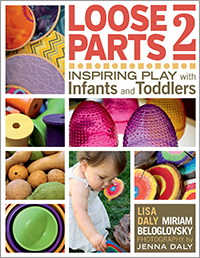
Note on Safety
Drawing on inspiration from Loose Parts: Inspiring Play in Young Children, this sequel highlights loose parts that are particularly appropriate for infants and toddlers. Every material represented in this book has been infant and toddler tested and teacher reviewed for safety. Even so, we caution that young children should never be left unattended with any of the objects. Supervision of children by observant adults is critical and always the best safety precaution.

